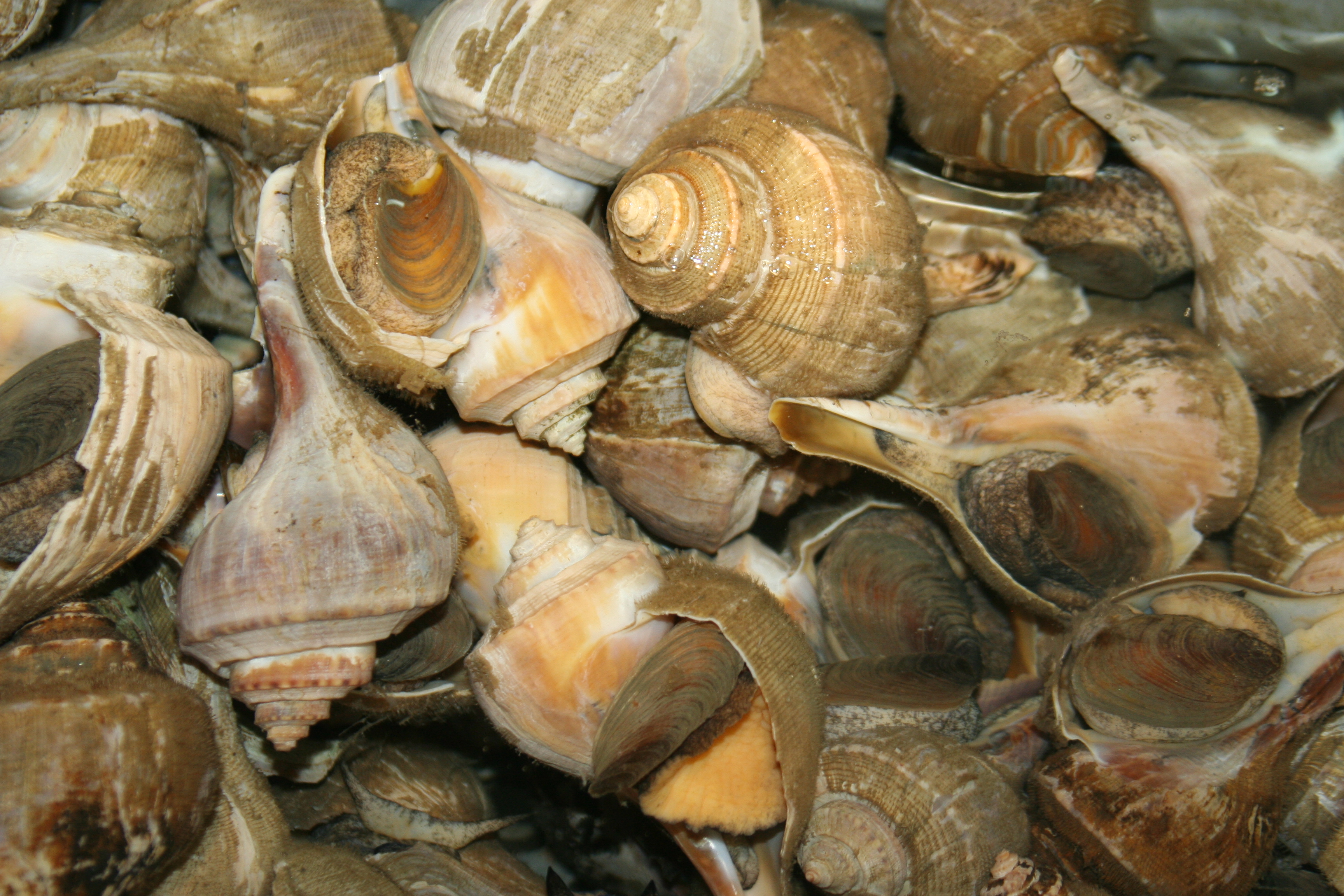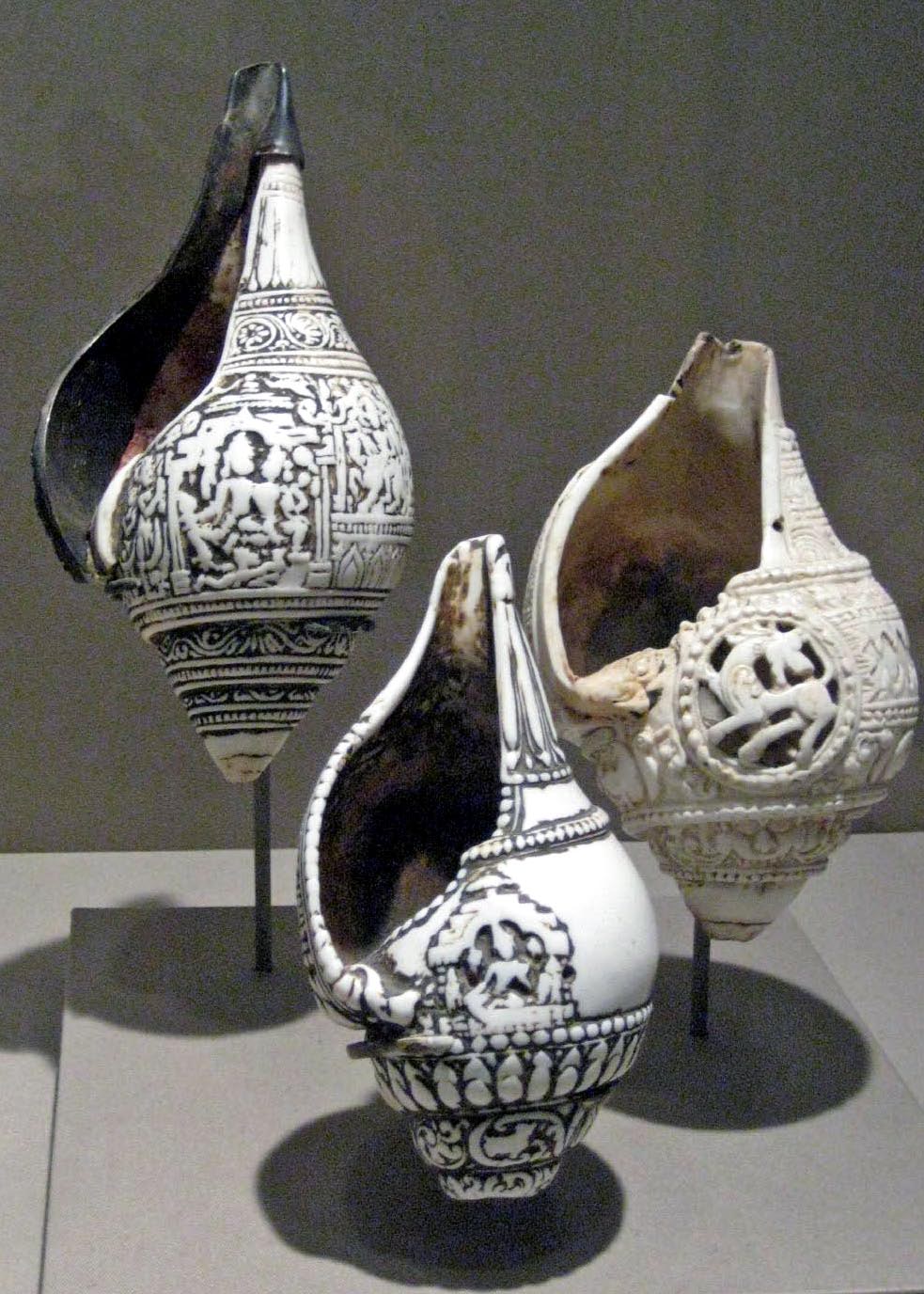|
Conch
Conch ( , , ) is a common name of a number of different medium-to-large-sized sea snails. Conch shells typically have a high Spire (mollusc), spire and a noticeable siphonal canal (in other words, the shell comes to a noticeable point on both ends). Conchs that are sometimes referred to as "true conchs" are Marine (ocean), marine gastropods in the family (biology), family Strombidae, specifically in the genus ''Strombus'' and other closely related genera. For example, ''Aliger gigas'', the queen conch, is a true conch. True conchs are identified by their long spire. Many other species are also often called "conch", but are not at all closely related to the family Strombidae, including ''Melongena'' species (family Melongenidae) and the horse conch ''Triplofusus papillosus'' (family Fasciolariidae). Species commonly referred to as conches also include the sacred chank or ''shankha'' shell (''Turbinella pyrum'') and other ''Turbinella'' species in the family Turbinellidae. The ... [...More Info...] [...Related Items...] OR: [Wikipedia] [Google] [Baidu] |
Queen Conch (Lobatus Gigas)
''Aliger gigas'', originally known as ''Strombus gigas'' or more recently as ''Lobatus gigas'', common name, commonly known as the queen conch, is a species of large sea snail, a marine gastropod mollusc in the family (biology), family of true conches, the Strombidae. This species is one of the largest molluscs native to the Caribbean Sea, and Tropical Atlantic#Marine provinces, tropical northwestern Atlantic, reaching up to in shell length. ''A. gigas'' is closely related to the goliath conch, ''Titanostrombus goliath'', a species endemic to Brazil, as well as the rooster conch, ''Aliger gallus''. The queen conch is herbivorous. It feeds by browsing for plant and algal material growing in the seagrass beds, and scavenging for decaying plant matter. These large sea snails typically reside in seagrass beds, which are sandy plains covered in swaying sea grass and associated with coral reefs, although the exact habitat of this species varies according to developmental age. The ... [...More Info...] [...Related Items...] OR: [Wikipedia] [Google] [Baidu] |
Shankha
A Turbinella pyrum, shankha () has religious ritual importance in Hinduism. In Hinduism, the shankha called panchajanya is a sacred emblem of the Hindu preserver deity Vishnu. It is still used as a trumpet in Hindu ritual, and in the past was used as a war trumpet. According to Arunava Bose, "The shankha is praised in Hindu scriptures as a giver of fame, longevity and prosperity, the cleanser of sin and the abode of goddess Lakshmi, who is the goddess of prosperity and consort of Vishnu". The shankha is displayed in Hindu art in association with Vishnu. As a symbol of water, it is associated with female fertility and serpents (nāgas). The shankha is one of the eight auspicious symbols of Buddhism, the Ashtamangala, and represents the pervasive sound of Buddhism. Characteristics This gastropod shell, shell is from a sea snail species ''Turbinella pyrum'' in the family Turbinellidae. This species is found living in the Indian Ocean and surrounding seas. The shell is porcelaneou ... [...More Info...] [...Related Items...] OR: [Wikipedia] [Google] [Baidu] |
Strombidae
Strombidae, common name, commonly known as the true conchs, is a Taxonomy (biology), taxonomic family (biology), family of medium-sized to very large sea snails in the superfamily (zoology), superfamily Stromboidea, and the Epifamily Neostromboidae. The term true conchs, being a common name, does not have an exact meaning. It may generally refer to any of the Strombidae but sometimes is used more specifically to include only ''Strombus'' and ''Lambis''.Goodenough, W. H. & Sugita, H. (1980).Trukese-English dictionary. Philadelphia: American Philosophical Society. p. 235] The family currently includes 31 Extant taxon, extant, and 10 extinct genera. Distribution Strombid gastropods live mainly in tropical and subtropical waters. These animals are widespread in the Indo-West Pacific, where most species and genera occur. Nearly 40 of the living species that used to belong to the genus ''Strombus'' can be found in the Indo-Pacific region.Abbott, R.T. (1960). "The genus ''Strombus'' ... [...More Info...] [...Related Items...] OR: [Wikipedia] [Google] [Baidu] |
Strombus
''Strombus'' is a genus of medium to large sea snails, marine (ocean), marine gastropod molluscs in the family (biology), family Strombidae, which comprises the true conchs and their immediate relatives. The genus ''Strombus'' was named by Swedish Naturalist Carl Linnaeus in 1758. Around 50 living species were recognized, which vary in size from fairly small to very large. Six species live in the greater Caribbean region, including the queen conch, ''Strombus gigas'' (now usually known as ''Eustrombus gigas'' or ''Lobatus gigas'' or Aliger gigas, Aliger gigas), and the West Indian fighting conch, ''Strombus pugilis''. However, since 2006, many species have been assigned to discrete genera. These new genera are, however, not yet found in most textbooks and collector's guides. Worldwide, several of the larger species are economically important as food sources; these include the endangered queen conch, which very rarely also produces a pink, gem-quality pearl. In the geological pas ... [...More Info...] [...Related Items...] OR: [Wikipedia] [Google] [Baidu] |
Triplofusus Papillosus
''Triplofusus giganteus'', commonly known as the Florida horse conch, or the giant horse conch, is a species of extremely large predatory subtropical and tropical sea snail, a marine gastropod mollusc in the family Fasciolariidae, the spindle snails, tulip snails and their allies.Rosenberg, G. (2018). ''Triplofusus giganteus'' (Kiener, 1840). In: MolluscaBase (2018). Accessed through: World Register of Marine Species at: http://www.marinespecies.org/aphia.php?p=taxdetails&id=420051 on 2021-07-02 On average, it weighs over . Although known as a horse conch, this is not a true conch, as it is not in the family Strombidae. With a shell length that can reach , this species is the largest gastropod in United States waters,Leal, J.H. (2002). Gastropods. p. 99-147. In: Carpenter, K.E. (ed.). The living marine resources of the Western Central Atlantic. Volume 1: Introduction, molluscs, crustaceans, hagfishes, sharks, batoid fishes, and chimaeras. FAO Species Identification Guide for Fi ... [...More Info...] [...Related Items...] OR: [Wikipedia] [Google] [Baidu] |
Turbinella Pyrum
''Turbinella pyrum'', common names the chank shell, sacred chank or chank, also known as the divine conch or referred to simply as a conch, is a species of very large sea snail with a gill and an operculum, a marine gastropod mollusk in the family Turbinellidae. This species occurs in the Indian Ocean. The name "chank" for the shell of this species is derived from the Indian word ''shankha'', the divine conch. The old generic name was ''Xancus''. The Dutch used to call them ''chianco''. Distribution This species is found mainly in the Indian Ocean. Description The shell of this species is massive, with three or four prominent columellar plicae. It is usually pure white under a heavy brown periostracum, but it can also be a pale apricot color. It can sometimes be dotted with dark brown. Shells of the lightning whelk (''Sinistrofulgur sp.''), a normally left-handed western Atlantic Ocean genus, are sometimes sold in imitation of the rare left-handed shells of the ''Tur ... [...More Info...] [...Related Items...] OR: [Wikipedia] [Google] [Baidu] |
Spire (mollusc)
A spire is a part of the coiled shell of molluscs. The spire consists of all of the whorls except for the body whorl. Each spire whorl represents a rotation of 360°. A spire is part of the shell of a snail, a gastropod mollusc, a gastropod shell, and also the whorls of the shell in ammonites, which are fossil shelled cephalopods. In textbook illustrations of gastropod shells, the tradition (with a few exceptions) is to show most shells with the spire uppermost on the page. The spire, when it is not damaged or eroded, includes the protoconch (also called the nuclear whorls or the larval shell), and most of the subsequent teleoconch whorls (also called the postnuclear whorls), which gradually increase in area as they are formed. Thus the spire in most gastropods is pointed, the tip being known as the " apex". The word "spire" is used, in an analogy to a church spire or rock spire, a high, thin, pinnacle. The "spire angle" is the angle, as seen from the apex, at which a s ... [...More Info...] [...Related Items...] OR: [Wikipedia] [Google] [Baidu] |
Gastropod
Gastropods (), commonly known as slugs and snails, belong to a large Taxonomy (biology), taxonomic class of invertebrates within the phylum Mollusca called Gastropoda (). This class comprises snails and slugs from saltwater, freshwater, and from the land. There are many thousands of species of sea snails and sea slug, slugs, as well as freshwater snails, freshwater limpets, land snails and slugs. The class Gastropoda is a diverse and highly successful class of mollusks within the phylum Mollusca. It contains a vast total of named species, second only to the insects in overall number. The fossil history of this class goes back to the Furongian, Late Cambrian. , 721 family (taxonomy), families of gastropods are known, of which 245 are extinct and appear only in the fossil record, while 476 are currently neontology, extant living fossil, with or without a fossil record. Gastropoda (previously known as univalves and sometimes spelled "Gasteropoda") are a major part of the phylum Mo ... [...More Info...] [...Related Items...] OR: [Wikipedia] [Google] [Baidu] |
Melongena Corona 2
''Melongena'' is a genus of sea snails, marine gastropod mollusks in the family Melongenidae, the crown conches and their allies.WoRMS (2010). Melongena Schumacher, 1817. In: Bouchet, P.; Gofas, S.; Rosenberg, G. (2010) World Marine Mollusca database. Accessed through: World Register of Marine Species at http://www.marinespecies.org/aphia.php?p=taxdetails&id=205587 on 2011-04-02 Species Species within the genus ''Melongena'' include: * † '' Melongena basilica'' (Bellardi, 1873) * '' Melongena bispinosa'' (Philippi, 1844) * † '' Melongena californica'' Anderson & Martin, 1914 F. M. Anderson and B. Martin. 1914. Neocene record in the Temblor Basin, California, and Neocene deposits of the San Juan District, San Luis Obispo County. Proceedings of the California Academy of Sciences, Fourth Series 4(3):15-112 * '' Melongena corona'' (Gmelin, 1791) - crown conch - synonym: ''Melongena subcoronata'' * † '' Melongena lainei'' (Basterot, 1825) * '' Melongena melongena'' (Linnaeu ... [...More Info...] [...Related Items...] OR: [Wikipedia] [Google] [Baidu] |
Melongenidae
The Melongenidae, the crown conchs and their relatives, are a taxonomic family of large to very large marine gastropods in the superfamily Buccinoidea.MolluscaBase eds. (2021). MolluscaBase. Melongenidae Gill, 1871 (1854). Accessed through: World Register of Marine Species at: http://www.marinespecies.org/aphia.php?p=taxdetails&id=160182 on 2021-02-27 Taxonomy For a while prior to 2004, the genera '' Busycon'' and '' Busycotypus'' were placed in the Melongenidae. Then, in 2004, based on their digestive system The human digestive system consists of the gastrointestinal tract plus the accessory organs of digestion (the tongue, salivary glands, pancreas, liver, and gallbladder). Digestion involves the breakdown of food into smaller and smaller compone ...s and on cladistic analysis by Kosyan & Kantor (2004),Kosyan A. R. & Kantor Yu. I. (2004). "Morphology, taxonomic status and relationships of Melongenidae (Gastropoda: Neogastropoda)". ''Ruthenica'' 14(1): 9-36abstract a ... [...More Info...] [...Related Items...] OR: [Wikipedia] [Google] [Baidu] |
Melongena
''Melongena'' is a genus of sea snails, marine gastropod mollusks in the family Melongenidae, the crown conches and their allies.WoRMS (2010). Melongena Schumacher, 1817. In: Bouchet, P.; Gofas, S.; Rosenberg, G. (2010) World Marine Mollusca database. Accessed through: World Register of Marine Species at http://www.marinespecies.org/aphia.php?p=taxdetails&id=205587 on 2011-04-02 Species Species within the genus ''Melongena'' include: * † '' Melongena basilica'' (Bellardi, 1873) * '' Melongena bispinosa'' (Philippi, 1844) * † '' Melongena californica'' Anderson & Martin, 1914 F. M. Anderson and B. Martin. 1914. Neocene record in the Temblor Basin, California, and Neocene deposits of the San Juan District, San Luis Obispo County. Proceedings of the California Academy of Sciences, Fourth Series 4(3):15-112 * ''Melongena corona'' (Gmelin, 1791) - crown conch - synonym: ''Melongena subcoronata'' * † '' Melongena lainei'' (Basterot, 1825) * '' Melongena melongena'' (Linnaeus ... [...More Info...] [...Related Items...] OR: [Wikipedia] [Google] [Baidu] |






